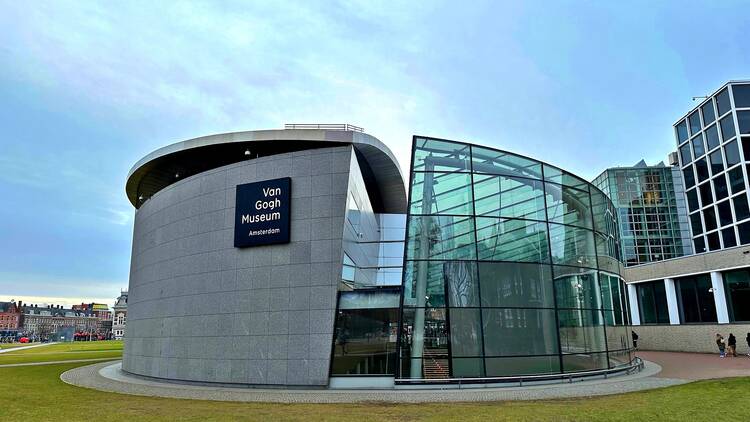Amsterdam, known for its picturesque canals and vibrant culture, is home to many world-famous attractions. One of the highlights is the Van Gogh Museum. This museum is devoted to the life and work of Vincent van Gogh.
It's a must-see for art lovers and anyone interested in learning about one of history's most fascinating artists. Located in the Museum Square, the Van Gogh Museum offers a deep dive into Van Gogh's masterpieces and personal life.
Van Gogh Museum Overview
Opened in 1973, the Van Gogh Museum consists of two buildings designed by renowned architects. The main structure, designed by Dutch architect Gerrit Rietveld, emphasizes geometrical forms and allows natural light into the exhibition space. In 1999, a new Exhibition Wing, designed by Japanese architect Kurokawa Kisho, was added. Together, these buildings create an open, welcoming space for visitors.
The Collection's Origin
The museum's core collection originally belonged to Theo van Gogh, Vincent's younger brother. It remained in the van Gogh family until 1962, when Vincent Willem van Gogh, the artist’s nephew, donated it to the Vincent van Gogh Foundation. The foundation then gave the collection to the museum on permanent loan. The collection has grown over the years through purchases and donations, now including works by Van Gogh's contemporaries like Paul Gauguin, Mary Cassatt, and Henri de Toulouse-Lautrec.
Highlights of the Van Gogh Museum
Ground Floor
Van Gogh’s Self-Portraits
Van Gogh created around 35 self-portraits, many of which are displayed on the ground floor. These portraits were mostly practice pieces, not meant for sale. Look closely at the back of some self-portraits, and you'll see that Vincent often reused older canvases due to lack of funds.
Sunflowers Reproduction
This exceptional reproduction is designed for people with vision impairments. It's the only painting in the museum you can touch and smell, giving you a unique sensory experience.
First Floor
The Potato Eaters
One of Van Gogh's first masterpieces, "The Potato Eaters," is displayed here. This painting captures the harsh life of peasants and showcases Van Gogh's early use of light and emotion.
Bedroom in Arles
This painting highlights Van Gogh's unique art style developed in the south of France. Its bold outlines and contrasting colors inspired many expressionist painters. There are multiple versions of this painting, with two others located in Paris and Chicago.
Sunflowers
One of Van Gogh’s most famous works, "Sunflowers," has seven versions. The version here is bright and joyful, almost entirely painted in yellow. It symbolizes the cycle of life, with fresh flowers contrasting with those going to seed.
Second Floor
Van Gogh’s Letters
Vincent's letters offer a glimpse into his gentle personality and artistic process. Written to his brother Theo and artist friends, these letters often included small drawings of his works in progress. You can read or listen to these letters on the second floor.
Painting Materials
This section of the museum is dedicated to Van Gogh’s painting techniques. You'll learn about the pigments he used, his experiments with colors, and the tools he created, such as the perspective frame.
The Yellow House
"The Yellow House" is where Van Gogh lived in Arles and dreamed of founding an art colony. This painting is displayed on the second floor and is one of his famous works.
Third Floor
Almond Blossom
Painted for his nephew, "Almond Blossom" symbolizes new life. This tranquil piece is one of Van Gogh's last works before his mental health deteriorated.
Irises
Van Gogh loved painting flowers, and irises were one of his favorite subjects. This large composition showcases his use of color and the symbolism of the life cycle.
Wheatfield with Crows
This painting, although not his last, symbolizes the end of Van Gogh's life. It depicts a vast wheat field with dark skies and black crows, suggesting different life paths and possibly foreshadowing his death.
Practical Information
Opening Hours
- March - September: Daily 9 am - 6 pm, Fridays until 9 pm (except 28 June and 27 September).
- October: 1 - 6 October: 9 am - 6 pm, Fridays until 9 pm; 7 - 10 October: 9 am - 5 pm; 11 - 31 October: 9 am - 6 pm, Fridays until 9 pm.
- November: 1 - 3 November: 9 am - 6 pm, Fridays until 9 pm; 4 - 30 November: 9 am - 5 pm, Fridays until 9 pm (except 29 November).
- December: 1 - 20 December: 9 am - 5 pm, Fridays until 9 pm; 21 - 23 December: 9 am - 6 pm; 24 - 26 December: 9 am - 5 pm; 27 December: 9 am - 9 pm; 28 - 30 December: 9 am - 6 pm; 31 December: 9 am - 5 pm.
Admission
All tickets include entry to the permanent collection and current exhibitions. Pre-book a timed entry ticket online.
Accessibility
The Van Gogh Museum ensures accessibility for all visitors. Companions of visitors with disabilities can enter for free. Various mobility aids and support for hidden disabilities like sensory sensitivity or PTSD are available.
Conclusion
A visit to the Van Gogh Museum in Amsterdam is a journey through the life and art of one of the most influential artists in history. With its vast collection, including his self-portraits, "The Potato Eaters," "Bedroom in Arles," and "Sunflowers," the museum offers a deep insight into Van Gogh's world.
Whether you are an art lover or simply curious, the Van Gogh Museum is a must-see on your trip to Amsterdam. Don't forget to book your Van Gogh Museum tickets in advance and explore this treasure trove of art and history.
